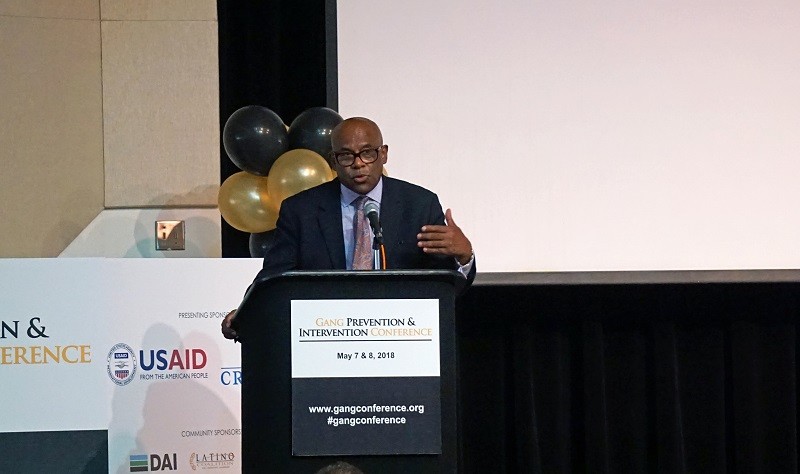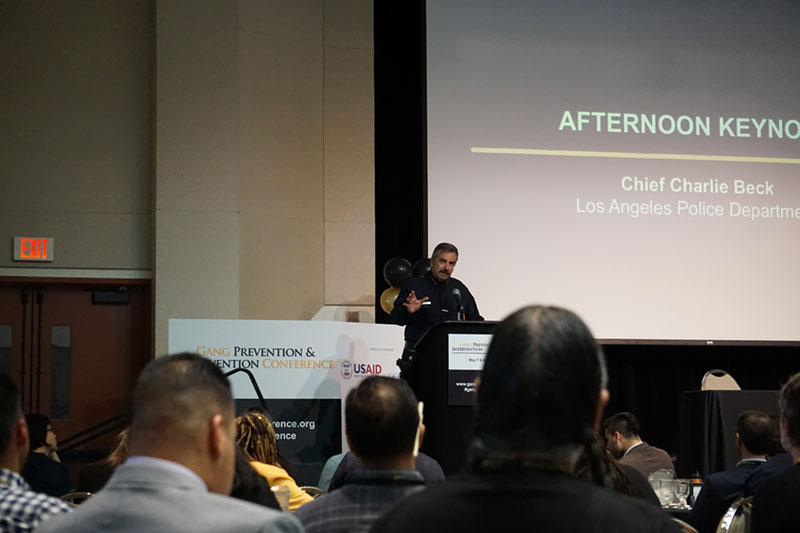Los AngelesDans son travail visant à endiguer la violence des gangs en Amérique centrale et à Los Angeles, Guillermo Cespedes a appris que la violence et les familles qui en sont victimes transcendent les frontières.
Il raconte souvent l'histoire de sa rencontre avec une victime d'une fusillade dans un hôtel de Los Angeles.. hôpital – un effort pour interrompre le schéma de représailles violentes – dont le premier appel téléphonique a été adressé à sa famille au Salvador.
« Le quartier est beaucoup plus grand que ce que nous pensions," dit Céspedes, s'adressant à un public de 600 à la septième édition Conférence sur la prévention et l'intervention contre les gangs, tenu en mai 7-8. « Nous utilisons habituellement le terme « transnational » pour parler de la criminalité.. Mais dans le cas de l'Amérique centrale, il y a une famille transnationale.

Parmi les personnes rassemblées à la conférence, d'anciens membres de gangs sont devenus des travailleurs d'intervention en matière de violence communautaire., chirurgiens traumatologues, policiers, les élus, militants de la société civile et autres – certains 150 les participants venaient de l'extérieur des États-Unis.
Céspedes, ancien maire adjoint de Los Angeles et directeur de son bureau de réduction des gangs et de développement de la jeunesse, a déclaré que la présence internationale à la conférence – qui augmente chaque année – correspond au sentiment croissant sur le terrain que ce qui se passe aux États-Unis et en Amérique centrale est interconnecté..
Actuellement conseiller principal en prévention du crime et de la violence chez Creative Associates International, Cespedes a également été chef adjoint du projet financé par l'USAID et mis en œuvre par Creative. Proposer plus projet au Honduras, qui utilise un modèle de conseil familial pour réduire le risque de violence chez les jeunes.
Dans ce poste et sa carrière à Los Angeles, il a travaillé avec de nombreuses familles avec des membres des deux côtés de la frontière.
Il a déclaré que même si les familles et les défis auxquels elles sont confrontées s'étendent au-delà des frontières internationales, les solutions aux violences doivent être adaptées à chaque contexte.
« Je pense que tout médicament exporté vers l’Amérique centrale en revient plus fort.," il a dit. "Mais je ne pense pas qu'il soit possible de prendre même ce qui est le plus efficace à Los Angeles.. et je le transfère soudainement en Amérique centrale. Je pense qu'il y a un processus d'adaptation qui doit avoir lieu. Cette adaptation nécessite vraiment de connaître les deux côtés, les deux contextes.
Permettre aux communautés de diriger
S'exprimant lors d'un panel plénier aux côtés de Cespedes, Rosita Amaya de Services de secours catholiques au Salvador a souligné l'importance d'impliquer les communautés dans la consolidation de la paix en fonction de leurs besoins et de leurs espoirs spécifiques..
« Nous devons d’abord demander aux personnes qui travaillent sur le terrain de voir ce qui fonctionne et de créer une stratégie collective.," dit-elle. « Mon rêve pour l’avenir est que nous soyons capables d’inclure les personnes qui peuvent réellement nous donner la réponse à ces problèmes. »
Cespedes a ajouté qu'un travail efficace de prévention de la violence ne s'adapte pas seulement au contexte local., mais reconnaît également que toutes les personnes présentes dans ce lieu ne devraient pas être traitées de la même manière, ou administré le même « médicament ».
« Ce qu’il faut, c’est le bon niveau d’intervention pour différents types de populations.," il a dit. « Tous les habitants d’un quartier n’ont pas le doigt sur la gâchette.. Nous devons nous adresser différemment à ceux qui ont les doigts sur la gâchette et à ceux qui envisagent peut-être de se procurer une arme à feu.
Tout au long de la conférence, les conférenciers et les participants ont souligné la nécessité d'une approche holistique qui associe la prévention de la violence., intervention ou interruption et application de la loi.
Les stratégies décrites comprenaient la visite des victimes de la fusillade à l'hôpital pour leur offrir une rampe de sortie et prévenir les représailles violentes.; reconquérir les parcs publics en zones de non-violence avec une programmation gratuite; et renforcer la collaboration entre la sensibilisation et les forces de l'ordre.
Équilibre entre application de la loi et prévention
David Kennedy, directeur du Réseau national pour des communautés sûres au Collège John Jay, a déclaré que l'une des causes profondes des cycles de violence est la détérioration de la légitimité du gouvernement et la confiance entre les communautés et l'État.

« Les violences graves sont concentrées dans de très petites populations de personnes exceptionnelles. Ils courent un risque astronomique, ils vivent dans des communautés qui ont été historiquement soumises à une oppression et à des dommages terribles et qui ne reçoivent pas le type d'attention et de soutien dont ils ont besoin," il a dit. « Si vous ne faites pas confiance à la police et que quelqu'un essaie de vous attaquer, tu ne vas pas demander de l'aide, vous allez vous en occuper vous-même.
Compte tenu de ce modèle, le renforcement des liens positifs entre les communautés et les forces de l’ordre est une étape essentielle pour endiguer la violence, les panélistes ont dit.
Dans ses remarques à la conférence, Chef du département de police de Los Angeles Charlie Beck a souligné la nécessité pour les forces de l'ordre de travailler main dans la main avec les efforts de sensibilisation communautaire pour améliorer les relations entre les quartiers et la police, qui ont souvent été brisées., comme lors de la guerre contre la drogue et les gangs menée dans la ville et qui a conduit à des milliers d’arrestations.
« Quand vous déclarez la guerre à une partie importante de la population, tu te déclares la guerre," il a dit. « La chose la plus importante qu’un département et une communauté puisse avoir, c’est la confiance. »
Avec un changement dans l’approche des forces de l’ordre, Beck a indiqué que la criminalité des gangs avait été réduite de moitié au cours des dernières années. 10 années et ça 2018 est en passe d'établir un nouveau plus bas taux d'homicides et de victimes par balle.
« Cela est réalisé par des centaines de personnes qui travaillent très dur pour changer la façon dont notre communauté se perçoit.," il a dit.
Mêmes principes, nouvel objectif
Bien que les principaux piliers de la prévention de la violence – une approche de santé publique associant des interventions appropriées à des niveaux de risque –, programmation holistique, partenariats, données et durabilité – sont restés au cœur de la conférence, de nombreux orateurs ont appelé à un effort continu pour réfléchir de manière critique et aborder les problèmes sous un nouvel angle.
« Dans ce domaine évolue, la lentille va se développer, ça va être affiné davantage," a déclaré Fernando Rejon, Directeur exécutif du Institut urbain pour la paix. « Nous en apprendrons davantage en regardant les choses sous différents angles. »
Pour certains, comme Amaya de Catholic Relief Services et Cespedes de Creative, cela signifie inverser le scénario en fonction des preuves et ne pas se concentrer uniquement sur ce qui manque aux communautés ou sur ce avec quoi elles luttent., mais d'où ils tirent leur force. Dans le cas du projet Proponte Más financé par l'USAID, cela a nécessité d'élargir la vision des facteurs de risque chez les jeunes en matière de participation aux gangs et à la violence pour examiner également les facteurs de protection, comme se sentir en sécurité à l'école.
« Il examine les données sous deux angles :, pas seulement ce qui ne va pas mais ce qui est bien," dit Céspedes. « Nous ne devons pas seulement être capables de déplacer la caméra et de trouver un angle différent., nous devons pouvoir retirer l’objectif de l’appareil photo.